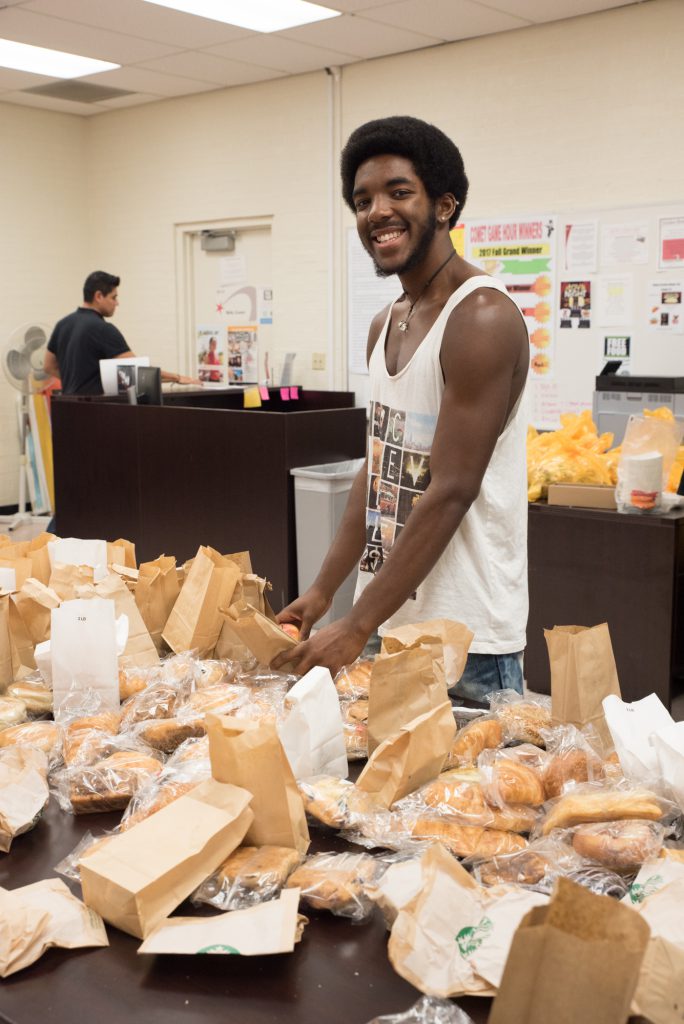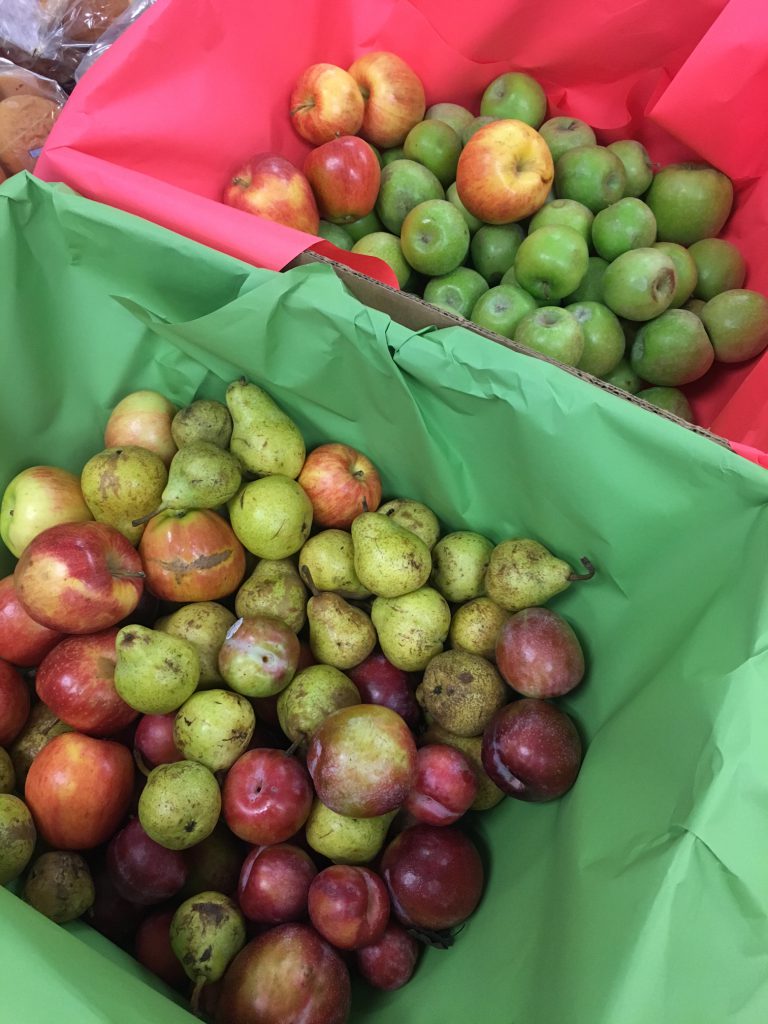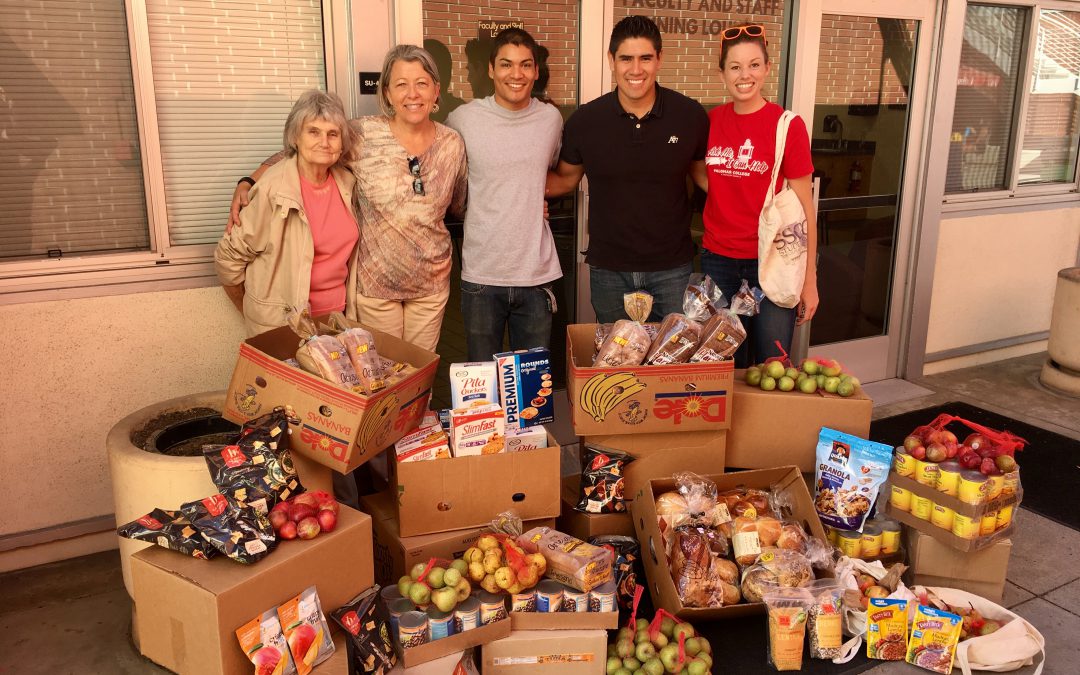The Student Affairs team at Palomar tackles food insecurity and plans 2018 expansion of Anita and Stan Maag Food & Nutrition Center.
SAN MARCOS — By noon on Thursday, Nov. 2, at least a hundred students had filed through a room filled with free food, picking up produce, pastries and bags of bagels on their way to class.
In the latest effort by the Palomar College Office of Student Affairs to address food insecurity, college staff and volunteers have coordinated Thursday food giveaways while planning for a significant expansion of the food pantry that Palomar has maintained for 34 years.
“We want students to be as well-prepared as they can be when they walk into the classroom,” said Sherry Titus, Director of Student Affairs. “If they’re not worried about where they’re getting their next meal, we know they’ll be more successful.”
The college currently sources its pantry supplies from the North County Food Bank on Rancheros Drive in San Marcos. The campus pantry has fed thousands of people over the decades, but lacks a refrigerator or a receiving dock.
When the Anita and Stan Maag Food & Nutrition Center moves to its new location in fall 2018, workers finally will have a refrigerator for keeping produce and dairy on hand, enough staging room to accept pallets of food, and an industrial sink.
Funded by a $400,000 donation from Bob Wilson, the new space will replace the old faculty and staff lounge when remodeling begins early next year.
“We’ll be able to bring in so much more product,” and students will have more nutritious food to choose from, Titus said.
The students are hungry
The United States Department of Agriculture (USDA) defines food security as “access … at all times to enough food for an active, healthy life.” Low food security, the USDA maintains, is marked by “reduced quality, variety, or desirability of diet,” and very low food security means “disrupted eating patterns and reduced food intake.”
According to a March 2017 study by the HOPE Lab at the University of Wisconsin-Madison, more than half of the community college students in the U.S. fall into the “low” or “very low” categories.
For the study, researchers surveyed 33,000 students across 70 community colleges in 24 states, and 60 percent of respondents said they couldn’t afford to eat balanced meals, while a third said they had cut back or skipped meals for three or more days in a row.
At Palomar, the efforts to address student hunger range from keeping granola bars on hand in the Student Affairs Office to providing Campus Police with emergency food supplies to hand out to homeless students.
On most Thursdays, starting at 11:30 a.m., more than 150 students stop by the SEAL (Success, Equity, Advocacy & Leadership) Center behind the cafeteria and leave with a bag of food. It’s more casual than scheduling an appointment to access the food pantry, and everyone is welcome.

Photo by Melinda Finn
“I think half the students who go to a community college could use some free food,” said Nursing student Chad Weigle. “I mean, it’s expensive. I have a part time job with bills to pay, and I’m in school.”
Between boxes filled with apples and pears, volunteer Miriam Garcia said she has started to recognize some of the regulars on free food Thursdays.
“I feel grateful to help,” said Garcia. “But also, I feel like, wow, this school (gives students) a lot of help. They hear ‘free food’ and they come in. Some of them really need it, you can tell. They’ll say, ‘Can I have two?’”
Monthly support
In a converted office across the hall from the SEAL Center, single mother Amanda Hudgins was taking her first look at the shelves that the Student Affairs team keeps stocked with canned and dry goods.
“This really helps, more than you know,” said Hudgins, who read a bulletin on the college website about free food and left campus with 22 pounds of tuna, Instant Ramen, fruit cups and pasta.
Hudgins said she is taking prerequisites to enter the Nursing program at Palomar: “I don’t have time for grocery shopping, going to school and working full time. And it’ll help with my budget, because I live check to check.
“I’m going to make spaghetti and chili, and I’ve got some soup that my little one can make for himself when he gets home from school,” she added.
Minutes earlier, Juan Gonzalez had walked Hudgins through the application process. Students who need to access the food pantry on a monthly basis are asked for some basic information, and may then schedule monthly visits.
Gonzalez, now 33, graduated from Palomar in 2006 and now serves as Student Activities Coordinator. Working with students week in and week out, he has encouraged some who were reluctant to take what they needed, and listened as a homeless student confessed that he was afraid he would be mugged if he left with a grocery sack full of food.
The next time, Gonzalez recalled, he came with his own backpack and filled it up.
“I wish I had known about this when I was a student,” said Gonzalez. “Sometimes I didn’t have money, and buying something to eat, it’s expensive. That’s why I feel so passionate about this.”
Added Titus: “We’ve seen kids just break down crying because they’re so grateful that they can actually have a meal. That gets me all teary-eyed.”

Photo courtesy of the Student Affairs Office
Titus said her team has been working to spread awareness of the pantry on campus, and at the same time to destigmatize it as a student resource.
“It’s just like going to tutoring—why would we discourage or stigmatize tutoring? Why would we stigmatize any other resource?” asked Titus. “So let’s make sure they’re comfortable, that they feel OK to come back. There’s no judgment.”
Gonzalez said that donations of food and personal hygiene items are accepted through the Office of Student Affairs. But financial donations can be even more impactful, since the college can buy food much more cheaply through the food bank than shoppers can in stores.
“We go to the North County Food Bank, and today, we bought over 400 pounds of food for only $50,” he said.
Learn more about the Palomar College Food & Nutrition Center.

